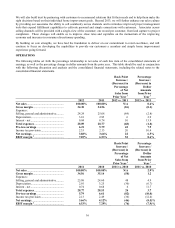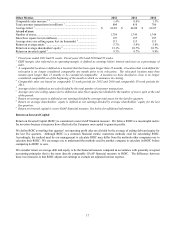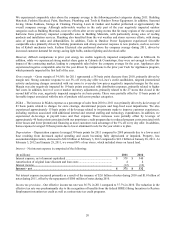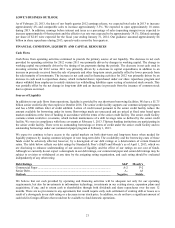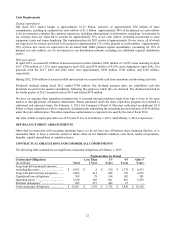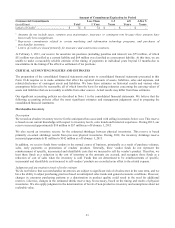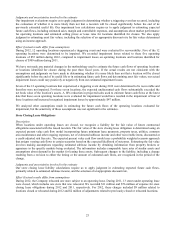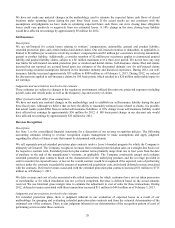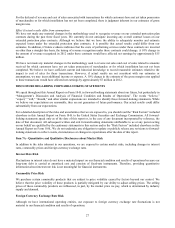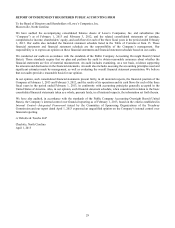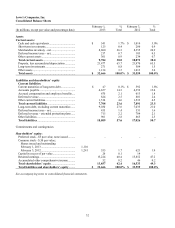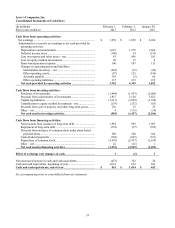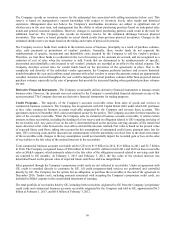Lowe's 2012 Annual Report Download - page 40
Download and view the complete annual report
Please find page 40 of the 2012 Lowe's annual report below. You can navigate through the pages in the report by either clicking on the pages listed below, or by using the keyword search tool below to find specific information within the annual report.26
We have not made any material changes in the methodology used to estimate the expected future cash flows of closed
locations under operating leases during the past three fiscal years. If the actual results are not consistent with the
assumptions and judgments we have made in estimating expected future cash flows, our store closing lease obligation
losses could vary positively or negatively from our estimated losses. A 10% change in the store closing lease liability
would have affected net earnings by approximately $5 million for 2012.
Self-Insurance
Description
We are self-insured for certain losses relating to workers’ compensation; automobile; general and product liability;
extended protection plan; and certain medical and dental claims. Our self-insured retention or deductible, as applicable, is
limited to $2 million per occurrence involving workers’ compensation and $3 million per occurrence involving automobile,
general or product liability. Additionally, a corridor retention of $2 million per occurrence applies to commercial general
liability and product liability claims, subject to a $6 million maximum over a three-year period. We do not have any stop
loss limits for self-insured extended protection plan or medical and dental claims. Self-insurance claims filed and claims
incurred but not reported are accrued based upon our estimates of the discounted ultimate cost for self-insured claims
incurred using actuarial assumptions followed in the insurance industry and historical experience. During 2012, our self-
insurance liability increased approximately $35 million to $899 million as of February 1, 2013. During 2012, we reduced
the discount rate applied to self-insurance claims by 100 basis points, which resulted in a $20 million unfavorable impact to
net earnings.
Judgments and uncertainties involved in the estimate
These estimates are subject to changes in the regulatory environment; utilized discount rate; projected exposures including
payroll, sales and vehicle units; as well as the frequency, lag and severity of claims.
Effect if actual results differ from assumptions
We have not made any material changes in the methodology used to establish our self-insurance liability during the past
three fiscal years. Although we believe that we have the ability to reasonably estimate losses related to claims, it is possible
that actual results could differ from recorded self-insurance liabilities. A 10% change in our self-insurance liability would
have affected net earnings by approximately $56 million for 2012. A 100 basis point change in our discount rate would
have affected net earnings by approximately $23 million for 2012.
Revenue Recognition
Description
See Note 1 to the consolidated financial statements for a discussion of our revenue recognition policies. The following
accounting estimates relating to revenue recognition require management to make assumptions and apply judgment
regarding the effects of future events that cannot be determined with certainty.
We sell separately-priced extended protection plan contracts under a Lowe’s-branded program for which the Company is
ultimately self-insured. The Company recognizes revenues from extended protection plan sales on a straight-line basis over
the respective contract term. Extended protection plan contract terms primarily range from one to four years from the date
of purchase or the end of the manufacturer’s warranty, as applicable. The Company consistently groups and evaluates
extended protection plan contracts based on the characteristics of the underlying products and the coverage provided in
order to monitor for expected losses. A loss on the overall contract would be recognized if the expected costs of performing
services under the contracts exceeded the amount of unamortized acquisition costs and related deferred revenue associated
with the contracts. Deferred revenues associated with the extended protection plan contracts increased $11 million to $715
million as of February 1, 2013.
We defer revenue and cost of sales associated with settled transactions for which customers have not yet taken possession
of merchandise or for which installation has not yet been completed. Revenue is deferred based on the actual amounts
received. We use historical gross margin rates to estimate the adjustment to cost of sales for these transactions. During
2012, deferred revenues associated with these transactions increased $11 million to $441 million as of February 1, 2013.
Judgments and uncertainties involved in the estimate
For extended protection plans, there is judgment inherent in our evaluation of expected losses as a result of our
methodology for grouping and evaluating extended protection plan contracts and from the actuarial determination of the
estimated cost of the contracts. There is also judgment inherent in our determination of the recognition pattern of costs of
performing services under these contracts.


